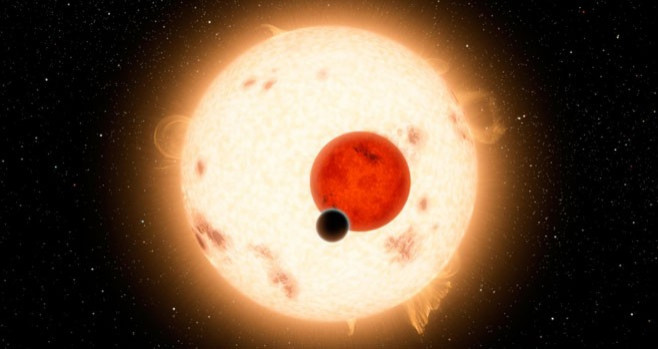Scientists Find Real 'Tatooine-Like' Planet With Two Suns

Scientists working with NASA's Kepler mission have discovered a planet containing two suns as shown by the 1977 sci-fi movie Star Wars, breaking several galactic assumptions that were previously thought to exist only in science fiction movies or books.
The movie Star Wars portrayed the existence of a planet Tatooine with a double sunset. Now, it has become a reality after 34 years.
The new planet, called Kepler-16b, is the most Tatooine-like planet yet found in our galaxy and lies 200 light years away from Earth. But, unlike the hot Tatooine, it is an inhospitable cold world thought to be made up of about half rock and half gas.
The planet has two stars, one about 69 percent the mass of the Sun and the other only 20 percent the mass of the Sun, which circle each other every 41 days.
Around both of them circles the Saturn-mass planet in a period of 229 days. Even though the planet has an orbital period of less than a year, it is still outside the habitable zone of the stars as the stars are much dimmer than our Sun.
Scientists have detected the new planet in the Kepler-16 system, a pair of orbiting stars that eclipse each other from our vantage point on Earth. When the smaller star partially blocks the larger star, a primary eclipse occurs, and a secondary eclipse occurs when the smaller star is completely blocked by the larger star.
Astronomers have observed that the brightness of the system dipped even when the stars were not eclipsing one another, hinting at a third body. The additional dimming in brightness events reappeared at irregular intervals of time, indicating the stars were in different positions in their orbit each time the third body passed. This showed the third body was circling, not just one, but both stars, in a wide circumbinary orbit.
Previous research has hinted at the existence of such circumbinary planets, but there was no clear confirmation. But, Kepler has detected such a planet by observing transits, where the brightness of a parent star dims from the planet crossing in front of it.
This discovery confirms a new class of planetary systems that could harbor life, said Kepler principal investigator, William Borucki.
Perhaps half the stars in the galaxy are in double star systems. Understanding that planets can form in close binary systems means that these, too, can be targets in the search for habitable worlds.
Most of what we know about the sizes of stars comes from such eclipsing binary systems, and most of what we know about the size of planets comes from transits, said Laurance Doyle of the SETI Institute. Kepler-16 combines the best of both worlds, with stellar eclipses and planetary transits in one system.
The discovery that such circumbinary planets can exist increases the likelihood of success of the Kepler Mission, which is the first NASA mission capable of finding Earth-size planets in or near the habitable zone, the region in a planetary system where liquid water can exist on the surface of the orbiting planet.
Kepler spacecraft, which has a planned mission lifetime of at least 3.5 years, has found more than 1,200 planets since its launch in March 2009.
Given that most stars in our galaxy are part of a binary system, this means the opportunities for life are much broader than if planets form only around single stars. This milestone discovery confirms a theory that scientists have had for decades but could not prove until now, Borucki said.
© Copyright IBTimes 2024. All rights reserved.





















